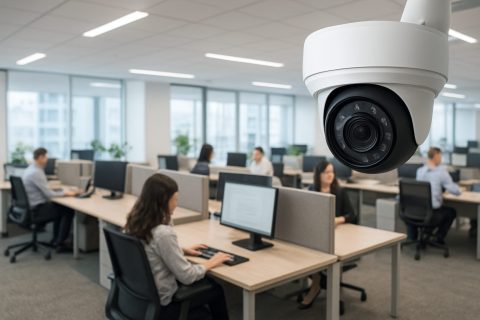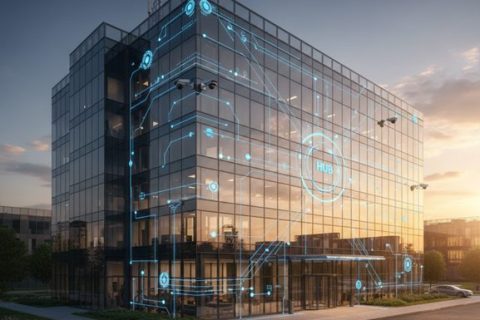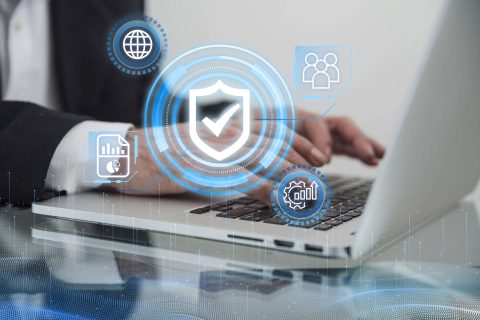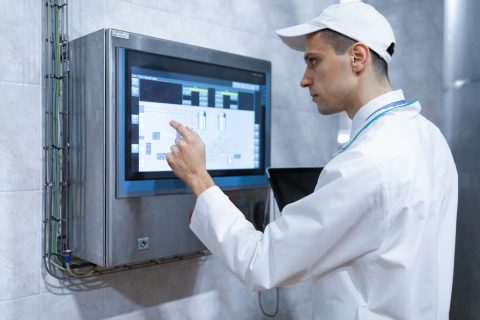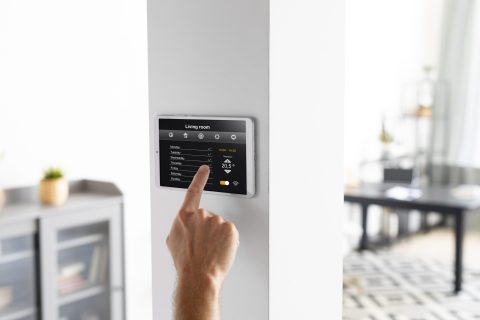In today’s rapidly evolving digital landscape, modern buildings demand more than basic electrical infrastructure. ELV systems have emerged as the backbone of intelligent building management, integrating security, communication, and automation into a unified network. These extra low voltage solutions from Vega Digital IT Solutions are transforming how businesses operate, offering enhanced safety, efficiency, and connectivity across commercial and residential spaces.
Key Takeaways:
- ELV systems are integrated low-voltage networks that power modern building automation, security, and communication infrastructure
- These systems reduce operational costs while enhancing safety through centralized control of HVAC, lighting, access control, and surveillance
- Implementing ELV and security systems together creates comprehensive protection and operational efficiency for commercial buildings
- Professional installation and maintenance ensure optimal performance and long-term ROI for building owners
What Are ELV Systems and Why Do They Matter?
ELV (Extra Low Voltage) systems operate at voltages typically below 50V AC or 120V DC, making them safer and more efficient than traditional electrical installations. An ELV system for buildings encompasses multiple integrated technologies including fire alarms, access control, CCTV surveillance, structured cabling, public address systems, and building management systems.
The growing adoption of smart infrastructure has made ELV systems essential rather than optional. According to recent industry analysis, the global building automation market is projected to reach $121 billion by 2026, driven largely by ELV technology integration. Organizations recognize that these systems provide measurable benefits in energy savings, security enhancement, and operational efficiency.
Modern facilities require seamless connectivity between different building functions. ELV systems provide this integration layer, allowing disparate technologies to communicate and work together harmoniously.
Core Components of Modern ELV Systems
Security and Surveillance Infrastructure
ELV and security systems form the foundation of comprehensive building protection. CCTV networks with IP-based cameras provide real-time monitoring and recording capabilities. Access control systems manage entry points using card readers, biometric scanners, and mobile credentials, ensuring only authorized personnel enter restricted areas.
Intrusion detection systems add another security layer by monitoring perimeters and triggering alerts when unauthorized access attempts occur. These components work together through centralized management platforms, enabling security teams to respond quickly to incidents.
Communication and Data Networks
Structured cabling systems deliver the physical infrastructure for voice, data, and video transmission throughout buildings. Fiber optic and Cat6/Cat6a cabling support high-bandwidth applications essential for modern business operations.
Public address and voice evacuation systems ensure clear communication during emergencies and routine announcements. These systems integrate with fire alarms to provide life-safety instructions when needed most.
Building Automation and Control
HVAC control systems optimize heating, cooling, and ventilation based on occupancy patterns and environmental conditions. Lighting management reduces energy consumption through automated scheduling, daylight harvesting, and occupancy sensors.
Building Management Systems (BMS) serve as the central nervous system, monitoring and controlling all integrated subsystems from a single interface. This centralization enables data-driven decision-making and predictive maintenance strategies.
Key Benefits of Implementing ELV Systems
Enhanced Operational Efficiency
Integrating multiple building functions through ELV infrastructure eliminates operational silos. Facility managers gain real-time visibility into building performance, identifying inefficiencies before they escalate into costly problems. Automated systems reduce manual intervention, freeing staff to focus on strategic initiatives rather than routine tasks.
Energy consumption decreases significantly when lighting, HVAC, and other systems respond intelligently to actual building conditions. Many organizations report 20-30% energy savings within the first year of comprehensive ELV system deployment.
Improved Safety and Security
Comprehensive ELV and security systems create multiple protective layers around people and assets. Video surveillance deters criminal activity while providing forensic evidence when incidents occur. Access control prevents unauthorized entry, protecting sensitive areas and valuable equipment.
Fire detection and alarm systems meet regulatory requirements while providing early warning that saves lives. Integration with emergency lighting and voice evacuation ensures orderly building evacuation when necessary.
Future-Ready Infrastructure
An ELV system for buildings provides the flexibility to adopt emerging technologies without major infrastructure overhauls. As artificial intelligence, machine learning, and IoT devices become standard, properly designed ELV networks accommodate these innovations seamlessly.
Scalability ensures that systems grow alongside organizational needs. Adding cameras, access points, or sensors requires minimal disruption when the underlying infrastructure supports expansion.
Industry Applications and Use Cases
Commercial Office Buildings
Modern office environments leverage ELV systems to create productive, comfortable workspaces. Smart lighting adjusts throughout the day to support circadian rhythms. Meeting room automation simplifies technology use, while desk booking systems optimize space utilization.
Security integration allows employees to use single credentials for building access, computer login, and print management. This unified approach enhances both security and user experience.
Retail and Shopping Centers
Retailers deploy digital signage systems powered by ELV infrastructure to deliver dynamic content that engages customers and drives sales. People counting sensors provide foot traffic analytics that inform staffing decisions and marketing strategies.
Loss prevention benefits from comprehensive surveillance coverage and intelligent video analytics that identify suspicious behavior patterns. These systems protect inventory while gathering valuable customer behavior insights.
Healthcare Facilities
Hospitals and clinics require reliable, life-critical systems where ELV infrastructure proves essential. Nurse call systems ensure rapid response to patient needs. Access control protects pharmaceuticals and sensitive patient areas. Environmental monitoring maintains proper temperature and humidity for medication storage and patient comfort.
Manufacturing and Industrial Facilities
Production environments utilize ELV systems for equipment monitoring, environmental controls, and safety systems. Real-time data from sensors enables predictive maintenance, reducing unplanned downtime. Surveillance systems monitor production processes and ensure worker safety compliance.
Choosing the Right ELV Solutions Provider
Selecting an experienced partner for ELV system implementation determines project success. Look for providers with proven expertise across multiple technology domains and industry verticals. Comprehensive project management capabilities ensure seamless coordination between design, installation, and commissioning phases.
Post-installation support and maintenance services protect long-term system performance. Regular system health checks, firmware updates, and training keep operations running smoothly while maximizing return on investment.
Certifications from technology manufacturers and industry organizations demonstrate technical competence and commitment to quality standards. Request case studies and client references that showcase similar project complexity and scale.
Best Practices for ELV System Implementation
Comprehensive Planning and Design
Successful deployments begin with a thorough needs assessment. Document current pain points, future growth plans, and budget constraints. Engage stakeholders from security, IT, facilities, and operations to ensure all requirements are captured.
Design scalable architectures that accommodate technology evolution. Plan cable pathways, equipment rooms, and power distribution with expansion in mind. Following structured cabling standards ensures interoperability and simplifies future modifications.
Professional Installation and Testing
Quality installation work prevents costly troubleshooting and rework. Certified technicians should handle all cable terminations, equipment mounting, and system configuration. Comprehensive testing validates that every component functions correctly and meets performance specifications.
Documentation including as-built drawings, equipment lists, and configuration settings enables efficient maintenance and troubleshooting throughout the system lifecycle.
Ongoing Maintenance and Optimization
Regular maintenance prevents system degradation and extends equipment lifespan. Schedule firmware updates, backup configuration data, and test failover mechanisms. Monitor system logs for anomalies that might indicate developing problems.
Periodic training ensures operators understand system capabilities and can respond effectively to alerts. As building use patterns change, optimize system parameters to maintain peak performance.
The Future of Smart Building Technology
Artificial intelligence and machine learning are transforming ELV systems from reactive to predictive. Advanced analytics identify patterns that humans might miss, enabling proactive interventions. Facial recognition, object detection, and behavior analysis enhance security while improving operational insights.
Cloud-based management platforms provide remote access and centralized control across multiple properties. This flexibility supports hybrid work models and distributed operations. Integration with enterprise software applications creates unified data ecosystems that drive business intelligence.
Sustainability initiatives increasingly rely on smart building technology. ELV systems contribute to LEED certification and other green building standards through energy optimization and resource conservation. As regulatory requirements tighten, comprehensive building automation becomes necessary for compliance.
Conclusion
ELV systems represent the foundation of modern smart building infrastructure, delivering tangible benefits in security, efficiency, and scalability. Whether upgrading existing facilities or designing new construction, investing in a comprehensive ELV system for buildings implementation positions organizations for long-term success. The integration of communication, security, and automation technologies creates environments where people work more productively, operations run more efficiently, and assets remain protected.
Organizations ready to transform their buildings into intelligent, connected spaces should partner with experienced digital transformation providers who understand both technology and business objectives. With proper planning, professional implementation, and ongoing optimization, ELV systems deliver measurable returns while creating future-ready infrastructure.
Frequently Asked Questions
What is an ELV system in a building?
An ELV (Extra Low Voltage) system is an integrated network of low-voltage technologies operating below 50V AC that powers modern building infrastructure. It includes security cameras, access control, fire alarms, communication networks, and building automation systems. These systems work together to enhance safety, efficiency, and connectivity in commercial and residential buildings.
What are the main components of ELV and security systems?
ELV and security systems comprise CCTV surveillance, access control systems, intrusion detection, fire alarms, and structured cabling networks. Additional components include public address systems, building management systems (BMS), and emergency lighting. These integrated solutions provide comprehensive protection while enabling centralized monitoring and control of all building functions.
How much does an ELV system for buildings cost?
The cost of an ELV system for buildings varies based on building size, complexity, and required features, typically ranging from $10-50 per square foot. Factors affecting price include the number of security cameras, access points, automation levels, and integration requirements. Professional assessment helps determine accurate budgets, and ROI often materializes within 2-3 years through energy savings and operational efficiency.
What is the difference between ELV and LV systems?
ELV (Extra Low Voltage) systems operate at voltages below 50V AC or 120V DC, while LV (Low Voltage) systems operate between 50-1000V AC. ELV systems are safer, require less regulatory compliance, and handle communication, security, and automation functions. LV systems power lighting, HVAC equipment, and general electrical outlets throughout buildings.
How long does it take to install an ELV system?
Installation timelines for ELV systems depend on building size and project scope, typically ranging from 2-12 weeks. Small office installations may take 2-4 weeks, while large commercial buildings require 8-12 weeks or more. Factors include infrastructure preparation, equipment complexity, testing requirements, and coordination with other construction activities.
Can ELV systems be integrated with existing building infrastructure?
Yes, modern ELV systems are designed for flexible integration with existing building infrastructure through retrofit solutions. Professional integrators assess current systems, identify compatibility requirements, and implement phased upgrades that minimize disruption. IP-based technologies and standardized protocols enable seamless connection between legacy and new equipment.
What maintenance do ELV systems require?
ELV systems require quarterly inspections, firmware updates, and annual comprehensive testing to maintain optimal performance. Regular maintenance includes checking camera functionality, testing access control systems, verifying backup power supplies, and cleaning equipment. Preventive maintenance programs extend system lifespan, reduce downtime, and ensure regulatory compliance for life-safety systems.
Are ELV systems suitable for small businesses?
Absolutely. Scalable ELV system designs accommodate small businesses with entry-level solutions that provide essential security and automation features. Small businesses benefit from cloud-based management, reduced energy costs, and enhanced security without significant upfront investment. Systems can expand as business needs grow, making them cost-effective long-term investments.
How do ELV systems improve building energy efficiency?
ELV systems reduce energy consumption by 20-30% through intelligent automation of lighting, HVAC, and equipment based on occupancy and environmental conditions. Smart sensors detect vacant spaces and adjust systems accordingly, while Building Management Systems optimize operations using real-time data. Automated scheduling prevents unnecessary energy use during off-hours.
What certifications should ELV system installers have?
Professional ELV installers should hold certifications from manufacturers like Honeywell, Siemens, or Schneider Electric, plus industry credentials such as BICSI RCDD (Registered Communications Distribution Designer). Relevant certifications include NICET (fire alarms), PSP (Physical Security Professional), and local electrical licensing. These credentials ensure installers follow best practices and maintain quality standards.

